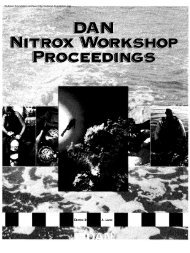Annual Diving Report - Divers Alert Network
Annual Diving Report - Divers Alert Network
Annual Diving Report - Divers Alert Network
You also want an ePaper? Increase the reach of your titles
YUMPU automatically turns print PDFs into web optimized ePapers that Google loves.
APPENDIX B. DIVE FATALITY CASE REPORTS<br />
04-56 Student in OW class with moderate heart disease, witnessed to have seizure on<br />
ascent<br />
Cause of Death: Drowning due to Air Embolism<br />
This 52-year-old male was a student in an initial open-water certification class who made a shore<br />
dive into the ocean with a buddy. The diver used a decongestant nasal spray prior to the dive<br />
because he was congested. His medical problems included an elevated cholesterol level and<br />
high blood pressure. The decedent suffered what appeared to his buddy to be a seizure while<br />
ascending from 51 fsw (16 msw). The problem seemed to occur at approximately 30 fsw (10<br />
msw). He was brought to the surface but could not be resuscitated. The autopsy demonstrated<br />
changes associated with drowning as well as moderate atherosclerosis of the coronary arteries<br />
and aorta. He also had intravascular gas and mediastinal emphysema. The death was<br />
determined to be a drowning due to an air embolism.<br />
04-29 Obese diver with heart disease on night dive for AOW certification, had problems<br />
with mask, panicked and made rapid ascent to surface and lost consciousness<br />
Cause of Death: Drowning due to Air Embolism due to Rapid Ascent<br />
This 50-year-old male had basic open-water certification with six lifetime dives. He was enrolled<br />
as a student in an advanced open-water class. The diver was also obese. During the day the<br />
diver completed two uneventful dives to 30 fsw (10 msw) and a night dive was planned for the<br />
evening. For the night dive the students entered the water from the boat; visibility was poor. The<br />
decedent had problems clearing his mask and spit out his regulator. Despite coaching by the<br />
instructor the student panicked and made a rapid ascent. He lost consciousness shortly after<br />
reaching the surface. The autopsy revealed changes associated with drowning as well as air<br />
embolism. He also had moderate to severe coronary artery disease and cholelithiasis.<br />
04-63 Solo diver certified many years with unknown experience, on spearfishing dive,<br />
made rapid ascent and lost consciousness at surface<br />
Cause of Death: Drowning due to Air Embolism due to Rapid Ascent<br />
This 42-year-old male had been a certified diver for twenty years, but his level of experience is<br />
unknown. The diver made a solo dive from a boat for the purpose of spearfishing. He surfaced<br />
from a dive to 89 fsw (27 msw) and rapidly lost consciousness. Resuscitation efforts were<br />
unsuccessful. The autopsy disclosed changes associated with drowning, as well as pulmonary<br />
and ear barotrauma, and gas in the arteries at the base of the brain. The decedent’s computer<br />
showed that he made a rapid ascent on this fatal dive profile and in fact that he habitually made<br />
rapid ascents.<br />
04-84 Infrequent diver with unknown experience and certification level, diving on<br />
rebreather for first time, separated from buddy, made rapid ascent and sank, body<br />
recovered later<br />
Cause of Death: Drowning due to Air Embolism due to Rapid Ascent<br />
The certification status and experience of this 56-year-old female is unknown and she had not<br />
made a dive in the previous two years. She was using a rebreather for the first time to make an<br />
ocean dive to 50-60 fsw (15-20 msw). While she had a buddy early in the dive, she was diving<br />
solo at the end. According to her computer she made a rapid ascent to the surface and then sank<br />
back down. Her body was recovered 30 minutes later. An autopsy was performed but only the<br />
death certificate was made available. The cause of death was listed as drowning but in all<br />
likelihood the diver likely was incapacitated by an air embolism.<br />
<strong>Annual</strong> <strong>Diving</strong> <strong>Report</strong>: 2006 Edition 73

















